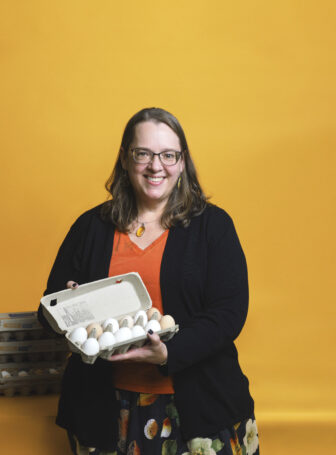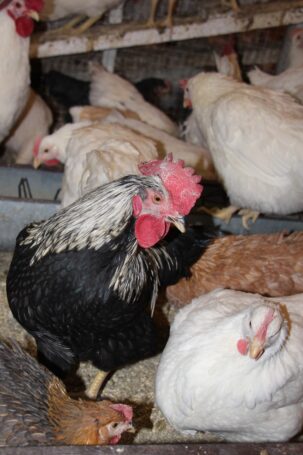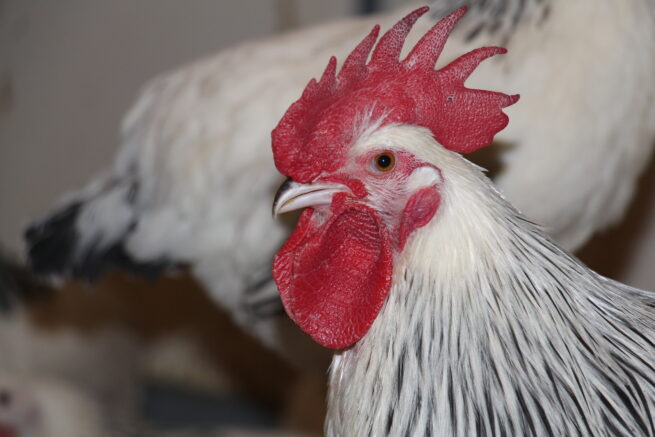December 14, 2023
University of Alberta program preserves genetic diversity one heritage chicken at a time
Every other week, Katrina Foster picks up a dozen eggs. They’re not uniform or all one colour, like the eggs you’d find at the grocery store. The shells range from white to light brown. Some have speckles. Inside, the yolks tend to be orange rather than yellow.
The size isn’t always the same, either. Foster has noticed the eggs she gets in January are smaller than the ones she gets later in the year. No matter the season, though, they’re delicious.
“I can taste the difference,” says Foster. “They just taste richer and more substantial.”

Foster is a longtime subscriber to the University of Alberta’s Adopt-a- Heritage-Chicken program, which launched in 2014 with help from a $40,000 grant from Edmonton Community Foundation.
Through the program, eggs from the 1,200 heritage chickens who live at the U of A’s Poultry Research Centre are sold to help cover the costs of keeping the flock at the farm. The program helps promote the conservation of unique genetic lines of poultry – from breeds such as Plymouth Rock, Light Sussex and Brown Leghorn.
Currently, the program has about 425 subscribers, who pay an annual subscription fee of $200 to get 20 dozen eggs per year.
There’s also a mini-subscription of 10 dozen eggs. The eggs come from all the different breeds, not just the subscriber’s particular adopted chicken.
“We give them a variety of eggs and it’s all random; just all these different heritage breed eggs. It’s sort of like a little rainbow,” says Taresa Chieng, Heritage Chicken Program Coordinator. Chieng enjoys interacting with the chickens.
“My favourite is the Light Sussex, because they’re really pretty. But the really friendly ones most often you see on TikTok videos, you see a lot of Plymouth Rocks, they’re really friendly and they’re really cuddly and fun.”

But along with the delicious eggs and cuteness factor, keeping these rare breeds of chickens — some of which were donated to the university as far back as the 1990s — is incredibly important for the future of poultry farming.
“Because a lot of the commercial breeds use the genetics from these heritage birds, if anything were to happen to the commercial breeds, we can actually go back to the heritage breeds and see where we went wrong, and correct it,” says Chieng. It’s also important to have them as a link to the past.
“It’s sort of like a living museum,” says Kerry Nadeau, Unit Manager at the Poultry Research Centre. “They’re the different types of chickens that used to be important to people back in the days where you’d raise all your own food.”
Today, commercial chickens are bred to be uniform, producing cartons of the same size and colour of eggs. “It’s the same with meat birds. You go to find a roasting chicken, they’re all sort of the same. Whereas with the older, heritage breeds, they show a lot of variation,” says Nadeau.
Over the years, they’ve also been “selected” to have various characteristics, according to trends of the day — for example, preferences for more breast meat or larger eggs. “Most chickens now, for meat, are white-feathered chickens, because people sort of get turned off if they see little pinpoint black marks on their chicken, which would be normal for a bird that had black feathers — it leaves a little bit of colour behind in the feather follicles,” says Nadeau.

But selecting for ostensibly more desirable characteristics can have consequences — another reason maintaining the genetic diversity of heritage breeds is important, Nadeau adds.
“There’s some interesting things that happen when you select birds for different traits,” she says. “Like, if you’re selecting for egg size and you always pick the birds that lay the biggest eggs, you may find that you’re selecting out — this is just a random example — resistance to disease or any number of things,” she says.
“So if you end up with a selection of birds where, after you select them over many generations, you find out the birds really aren’t very good at dealing with any of the diseases you might find in the environment, you can go back and look at heritage breeds and try to breed that hardiness into the flock.”
Genetic selection in chickens is a bit different than in cows, for example, Nadeau says, because chickens go from one generation to the next in a much shorter time — a chicken can have its first chicks at five months old.
The chickens at the Poultry Research Centre are rare breeds and random bred strains, partly obtained from Dr. Roy Crawford’s research flocks at the University of Saskatchewan. Crawford kept the breeds as an unselected population — often used as a reference group for comparison in genetic studies — since 1965. When he retired, they were given a new home at the U of A’s poultry centre.
The crucial need to protect the genetics contained in the flock is one of the reasons program subscribers don’t actually get to meet their adopted birds, Nadeau says.
Maintaining the integrity of poultry flocks by guarding against infection or other contaminants is an imperative element of food security.
“If the birds got sick and died, there’s nowhere to get new ones from. They would just be gone. So we have to be pretty careful. We do a lot of things to try and reduce the risks, so we keep out people that don’t really need to be on site.”
The chickens, which live in a free-run environment with wood shavings to use as bedding material, can also get stressed by changes in their space. “Sort of as a general rule, they don’t like strangers,” says Nadeau.
Foster was first captivated by chickens while living in the Cayman Islands, where feral chickens roam at will.
“I just thought they were charming, and they always looked so soft,” she says, adding the Adopt- a-Heritage-Chicken program is a great way to satisfy her chicken interest without raising them in her backyard.
Foster’s first “adopted” hen was a Rhode Island Red she named Yolk-abel. Over the years, she’s adopted a chicken from each of the different breeds raised at the poultry centre.
Though she doesn’t get to hang out with the chickens like she did in the Cayman Islands, she still feels a connection with them.
“I know my chickens, I know where my eggs are coming from,” she says. “I can talk to the people in the program and say, ‘How are the chickens doing?’ And I know I’m supporting this worthwhile program.”
Find out more at heritagechickens.ualberta.ca.
This story comes from the Winter 2023 edition of Legacy in Action. Read the full magazine.